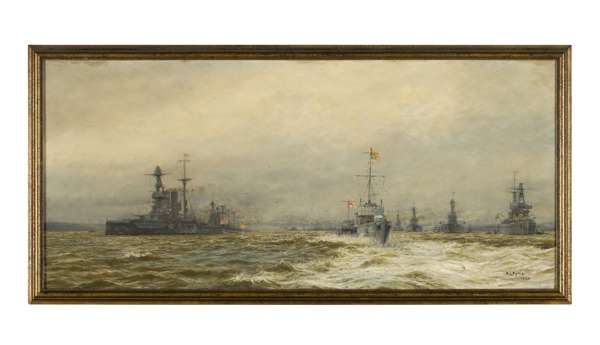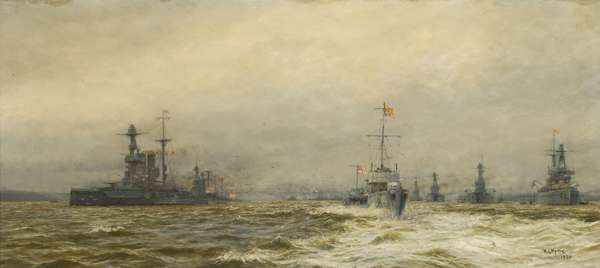
Lot 57

WILLIAM LIONEL WYLLIE R.A. (BRITISH 1851-1931)
REVIEW OF THE GRAND FLEET IN THE FIRTH OF FORTH AFTER THE ARMISTICE






Auction: 27 November 2015 at 11:00 GMT
Description
Signed and dated 1920, oil on canvas
Dimensions
46cm x 101.5cm (18in x 40in)
Footnote
Note: Often referred to as the leading marine artist of the 19th century, William Leopold Wyllie was, and indeed remains, immensely popular with collectors. He was a great admirer of Whistler and Turner and sought to evoke a similar sense of atmosphere through sensitive observation of light and weather conditions. He was also extremely engaged with his subject matter at an academic level, having studied the history of ship building alongside his artistic training at the Royal Academy Schools, in order to better inform his paintings.
The painting offered here is a large, exceptional example, combining to great effect the elements that ensure his work has such great and enduring appeal. The Royal Standard is raised high, denoting an occasion of significance, and the iconic Forth Rail Bridge, visible in the background, places us in the Firth of Forth. The choppy green waves are meticulously described and we, the viewer, appear to look back from the stern of a ship observing a fleet of battleships follow in our wake.
On this evidence it can be confidently posited that this work depicts one of naval history's most significant events: the review of the Grand Fleet in the Firth of Forth after the Armistice, 1918. The largest gathering of warships at any point in history before or since, the Royal Navy ensured that defeat of the enemy was total by insisting on the complete capitulation and interment of the German Fleet. It likely shows the moment when the Grand Fleet (370 warships, including 33 battleships and 90,000 men, with the Sixth Battle Squadron, comprising USN battleships, and some French cruisers) processed to meet the German units (9 battleships, 5 battlecruisers, 7 light cruisers and 49 destroyers), escorting them to temporary anchorage 40 miles east of the Isle of May before their removal to Scapa Flow, Orkney.





